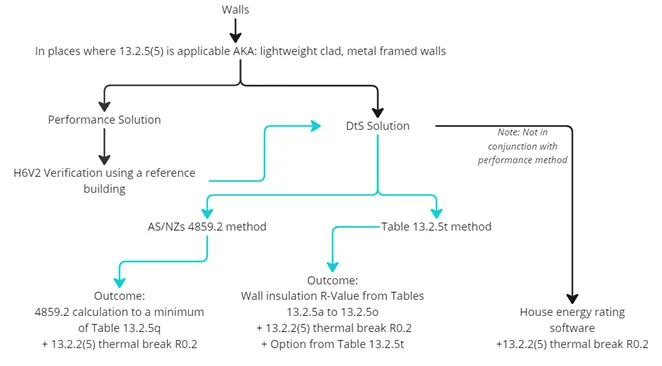When to use a Thermal Break
One of the more practical outcomes of the research was to answer the question: When do you need to use a thermal break to satisfy 13.2.5(5)? The time this question became most relevant was when a metal stud frame wall had metal battens fixed to the studs. More specifically, what is the definition of a metal frame? Does this include the metal battens? The research used both grammatical and technical analyses to determine the intent of the clause. The outcome of this analysis demonstrated that the thermal breaks are required both when a wall has a metal frame without battens and when the wall has metal battens. This is then illustrated by the flowchart below
What about the explanatory information of 13.2.5?
There is an explanatory information section in 13.2.5 that states: 'Because of the high thermal conductance of metal, a thermal break is needed when a metal framing member directly connects the external cladding to the internal lining or the internal environment...'. An argument is made by some, that because this explanatory information states 'directly connects', then this means that the metal battens are not included in the definition of a metal frame. However, this a logical fallacy known as denying the antecedent. It is equivalent to stating:
If you are an engineer, then you have a job.
You are not an engineer.
Therefore, you do not have a job.
It's clear to see that this is not a valid argument. The same logic applies to the explanatory information. It demonstrates a specific case where a thermal break is required. This does not mean that this is the only circumstance where a thermal break is required. The full research then uses the demonstrated methodology of AS/NZS 4859.2 to validate this statement. Indeed, the research supports the explanatory information statement, but it also supports the fact that a thermal break is required when a wall with a metal stud has metal battens.
What about the explanatory information of 13.2.5?
There is an explanatory information section in 13.2.5 that states: 'Because of the high thermal conductance of metal, a thermal break is needed when a metal framing member directly connects the external cladding to the internal lining or the internal environment...'. An argument is made by some, that because this explanatory information states 'directly connects', then this means that the metal battens are not included in the definition of a metal frame. However, this a logical fallacy known as denying the antecedent. It is equivalent to stating:
If you are an engineer, then you have a job.
You are not an engineer.
Therefore, you do not have a job.
It's clear to see that this is not a valid argument. The same logic applies to the explanatory information. It demonstrates a specific case where a thermal break is required. This does not mean that this is the only circumstance where a thermal break is required. The full research then uses the demonstrated methodology of AS/NZS 4859.2 to validate this statement. Indeed, the research supports the explanatory information statement, but it also supports the fact that a thermal break is required when a wall with a metal stud has metal battens.

